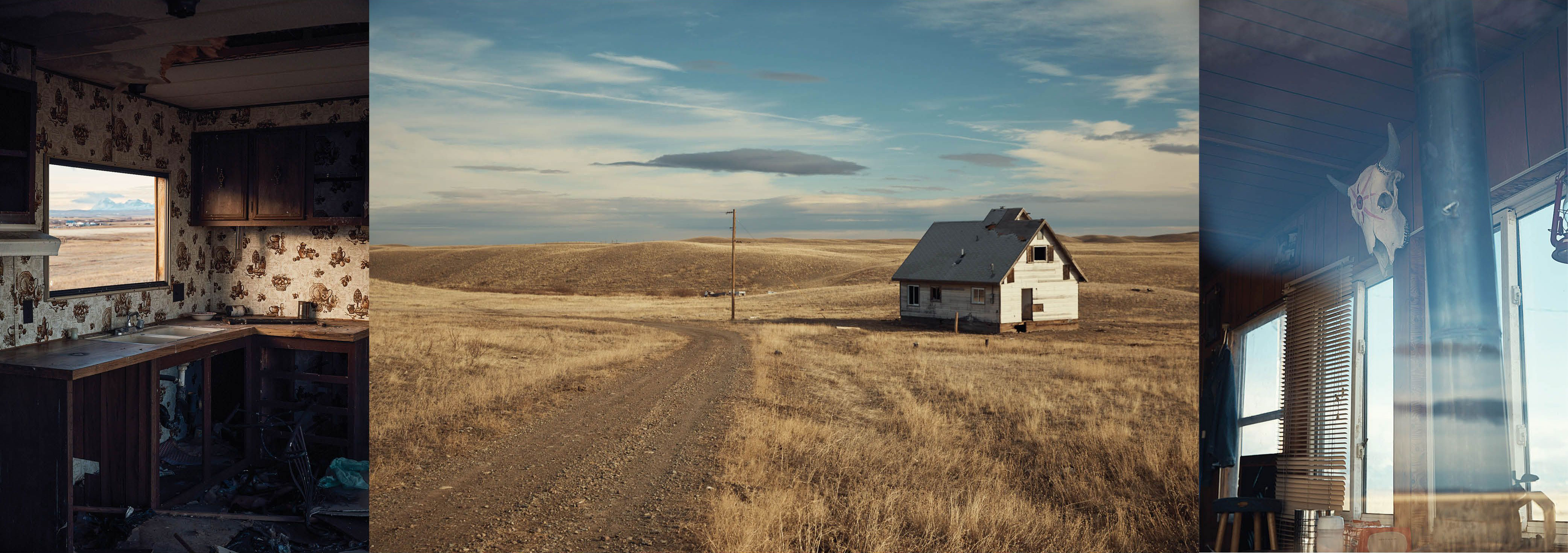The Invisible Victims
Two years ago, Ashley Heavy Runner Loring vanished without a trace, like thousands of other Native American women who go missing at alarming rates every year. Around the country, a remarkable movement, driven by Native women themselves, is leading the charge to find them.
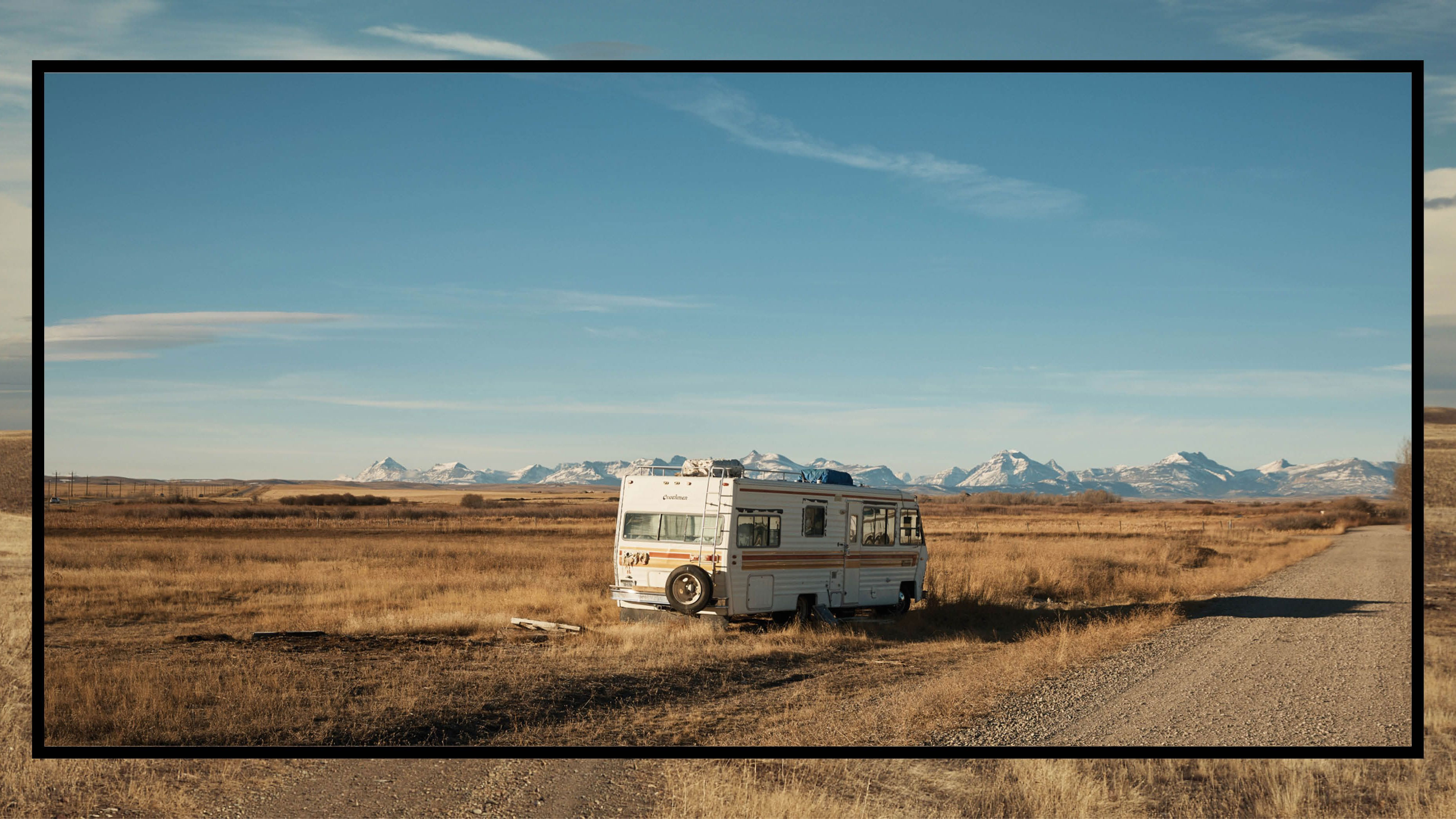
In June 2017, sisters Ashley and Kimberly Heavy Runner Loring were full of plans. Ashley hoped to leave her home on the Blackfeet Indian Reservation, east of Glacier National Park in Montana, later that summer for Missoula, where she would live with Kimberly while studying environmental science at the University of Montana. But while Kimberly was away for a few months getting to know her fiancé’s family in Morocco, Ashley grew despondent. The then-20-year-old was devastated following a breakup and often texted her sister for advice. “It was like her world was ending,” says Kimberly, now 25. Ashley cried more often and kept to herself. She stopped attending her classes at Blackfeet Community College and befriended a decades-older crowd, which included some who were rumored to sell and use drugs like meth. In early June, she called Kimberly, saying she needed money. Kimberly couldn’t send it from Morocco but promised she would be home in just a few days. But before Kimberly returned to Montana, Ashley vanished.
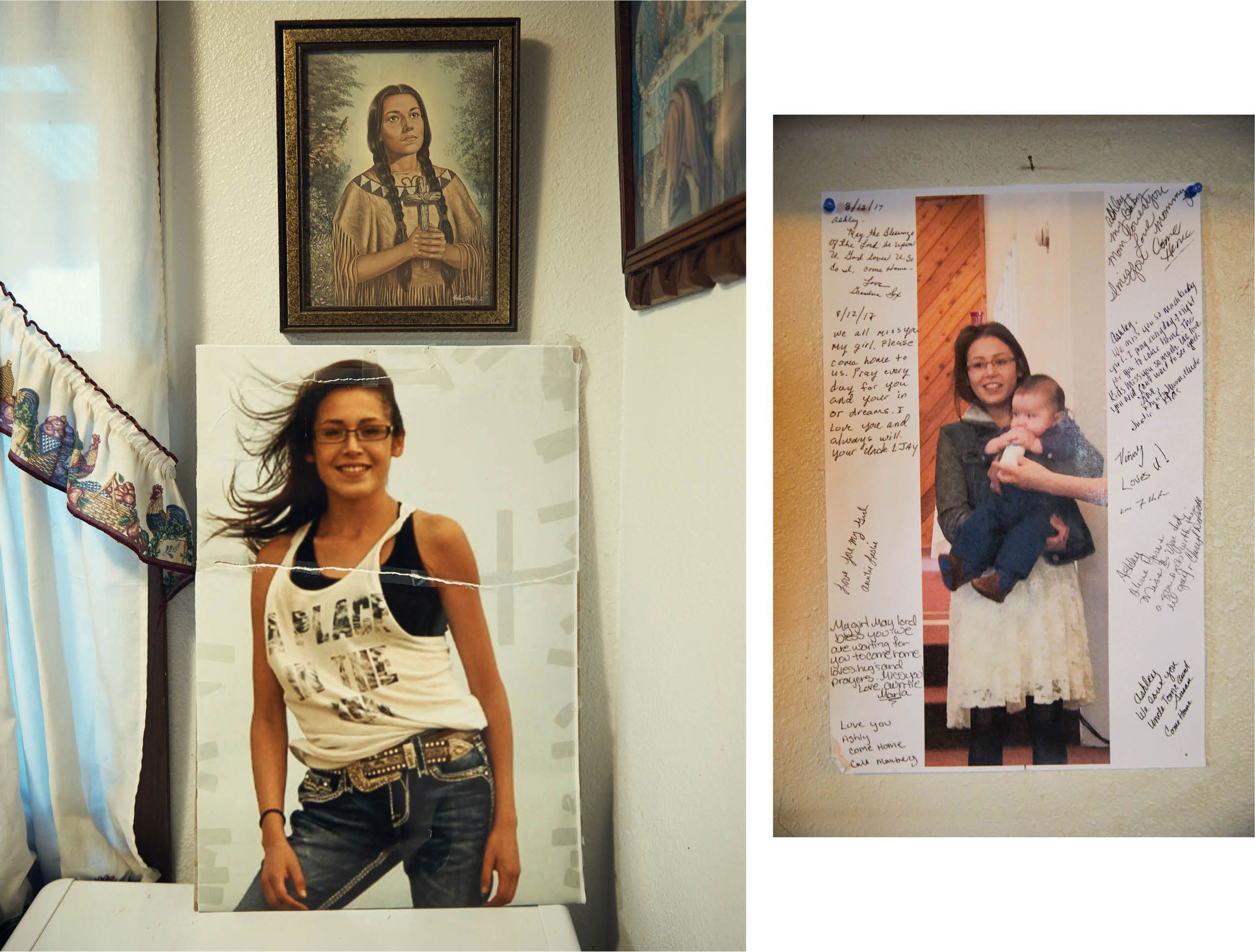
Pictures of Ashley in her family's house. The second, made into a poster after Ashley vanished, is scrawled with messages from her friends and family.
Unable to reach Ashley for days, her grandmother Loxie Loring reported her missing at the tribal police station in Browning, Montana, the reservation’s largest town and governing seat. But she says police told her that Ashley didn’t want to be found, that word around town was she was part of a raucous crowd and probably off partying somewhere. “We kept telling them, ‘It’s not like her,’” Kimberly says. Ashley always called.
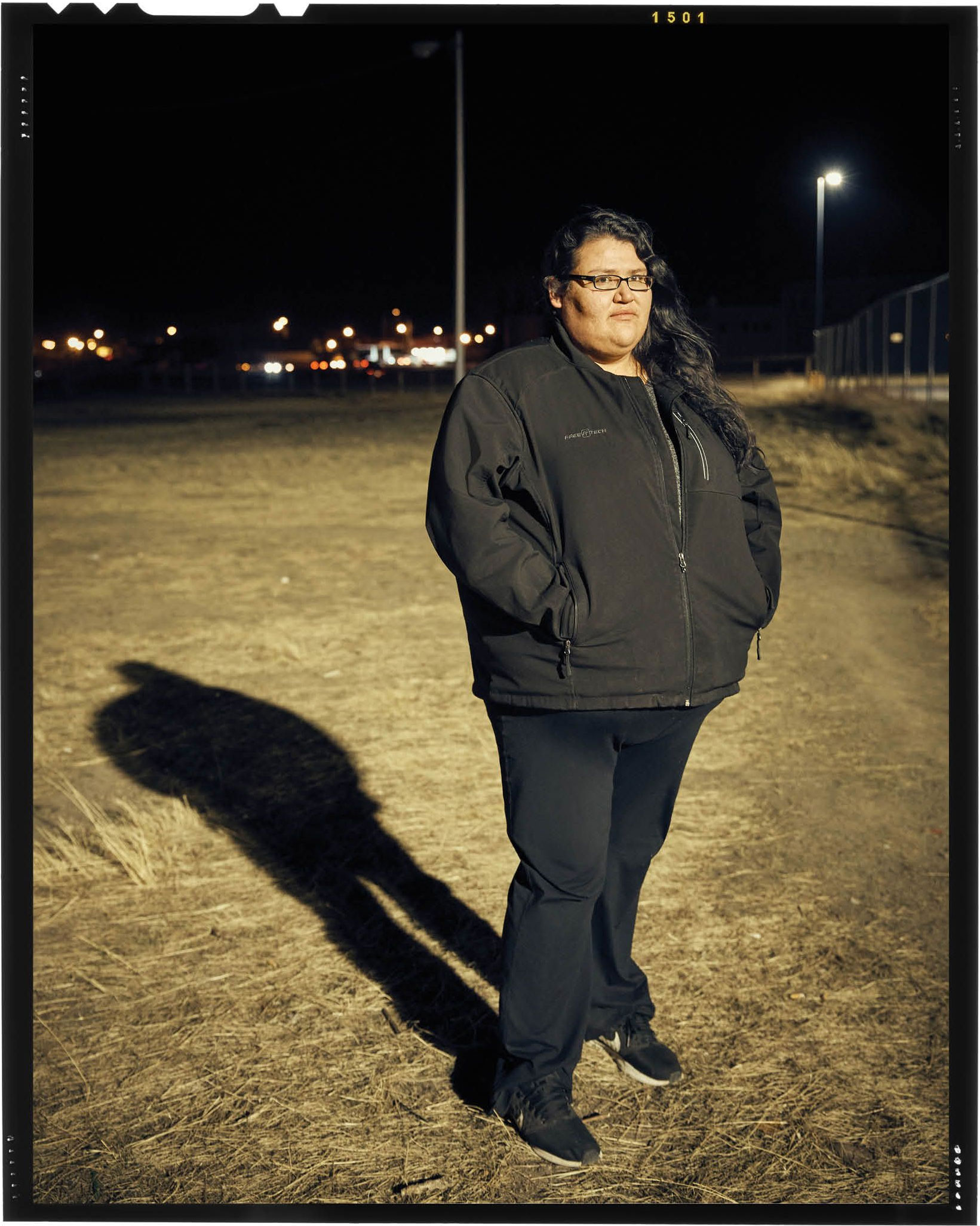
Kimberly Heavy Runner Loring, Ashley's older sister, has led the search for her.
Upon her return, frantic at what she believed was police inaction, Kimberly organized the first of what would become more than a hundred search parties over the next two years. Ashley’s family and friends combed the wilderness looking for clues but had little to go on. The reservation spans 1.5 million remote acres, Glacier National Park another million; vast, open plains stretch hundreds of miles east and northward into Canada. Kimberly had no idea where Ashley could be in all that space.
Like many communities that have experienced historical trauma, a term that describes how colonization and violence can affect families and communities for generations, the reservation, home to around 7,000 Blackfeet residents, has long weathered poverty and crime. The unemployment rate of nearly 11 percent is around three times that of the state; in Glacier County, where the reservation partly sits, the average annual income is less than $17,000, with more than a third of the people living below the poverty line.

In the small town of Blackfeet, MT, near where Mark Surechief lives.
In 2017, Browning was still reeling from the unsolved murder of Matthew Grant, whose body had been found the previous winter. Many assumed it was drug related; in recent years, Blackfeet lands had been flooded with opioids, meth, and the crimes that came with them. The tribe’s governing body even declared a state of emergency last October, linking crisis-level drug and alcohol use to a spike in criminal activity. And locals had complained for years that law enforcement was ineffective, even corrupt, when it came to protecting Natives. In 2000, a review issued by the Bureau of Indian Affairs (BIA) accused the tribal police of gross mismanagement. In 2003, a 13-year-old was raped, and doctors called for an investigator; no one showed up. Three years later, the BIA initiated a forced takeover: BIA agents armed with assault rifles filed into Browning, forcing out 13 police officers in the tribal police department. Years later, after the tribal government passed a resolution to phase out BIA control in 2010 and hand law enforcement back to the tribe, claiming the BIA had been just as lax in protecting citizens from crime, many locals still fear that criminals find impunity on the reservation.
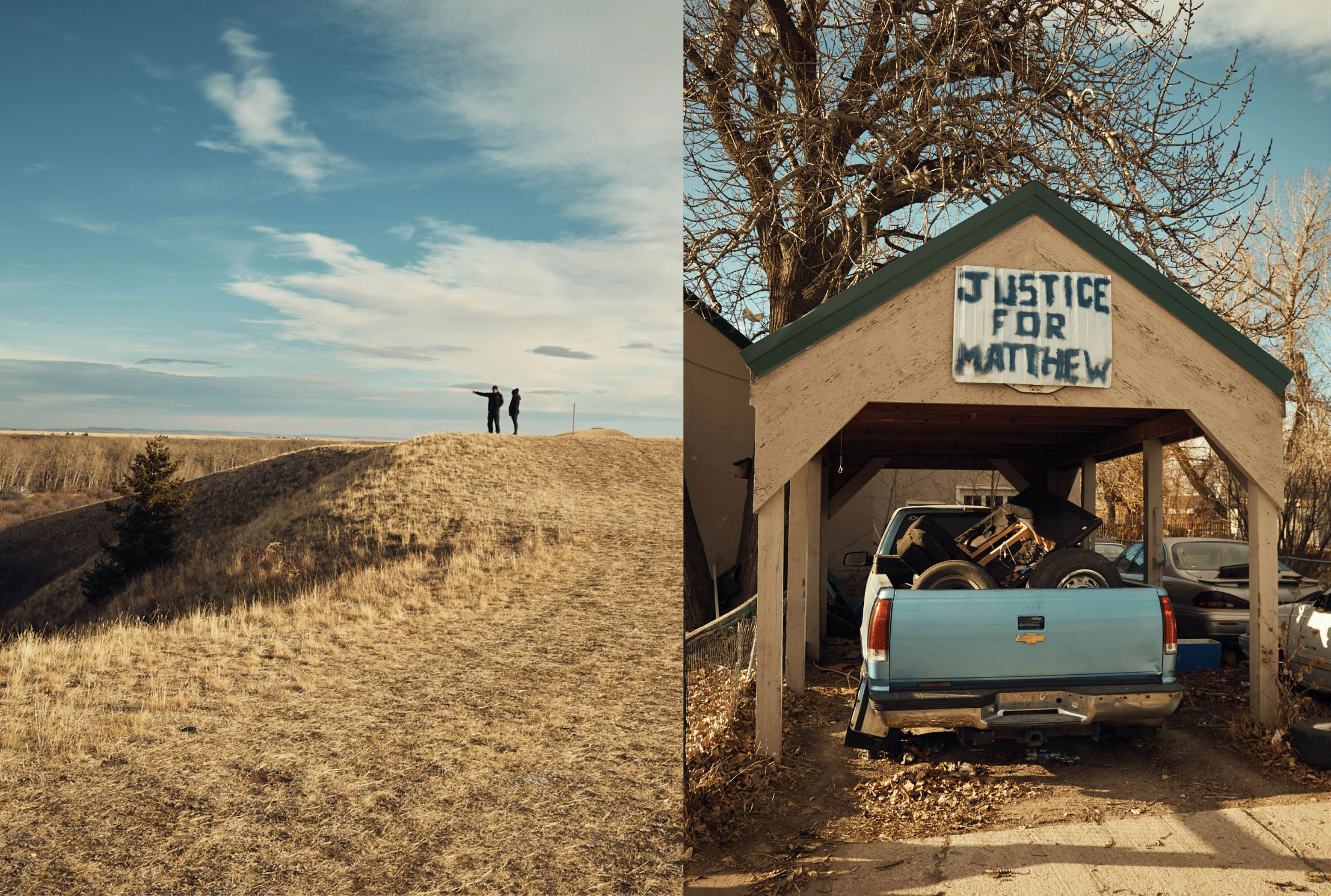
Left: Mark SureChief shows the author the area where locals searched for Ashley's body. Right: A home in Browning, MT, protesting the murder of Matthew Grant.
Kimberly knew how dangerous the world could be for Native women. She had heard about the disproportionate number who were trafficked, missing, or found dead. Just north of the reservation’s border, the Canadian government launched a high-profile national investigation in 2016 into the deaths and disappearances of reportedly thousands of indigenous women. But the fear was also felt closer to home. Just months earlier, another local Blackfoot woman, Charlene Mancha, 51, had been killed when her husband ran her over with his truck. And now the rumors about Ashley swirled: She’d been eaten by a mountain lion or sold into the sex trade; pieces of her had been found lodged in a dam or stuffed in an oil barrel. Someone had spotted her running from a car down an isolated road. All of it seemed terrifyingly possible. The last person to see her—one of her new, older friends—claimed he dropped her off on a remote road one night because another friend was going to pick her up.
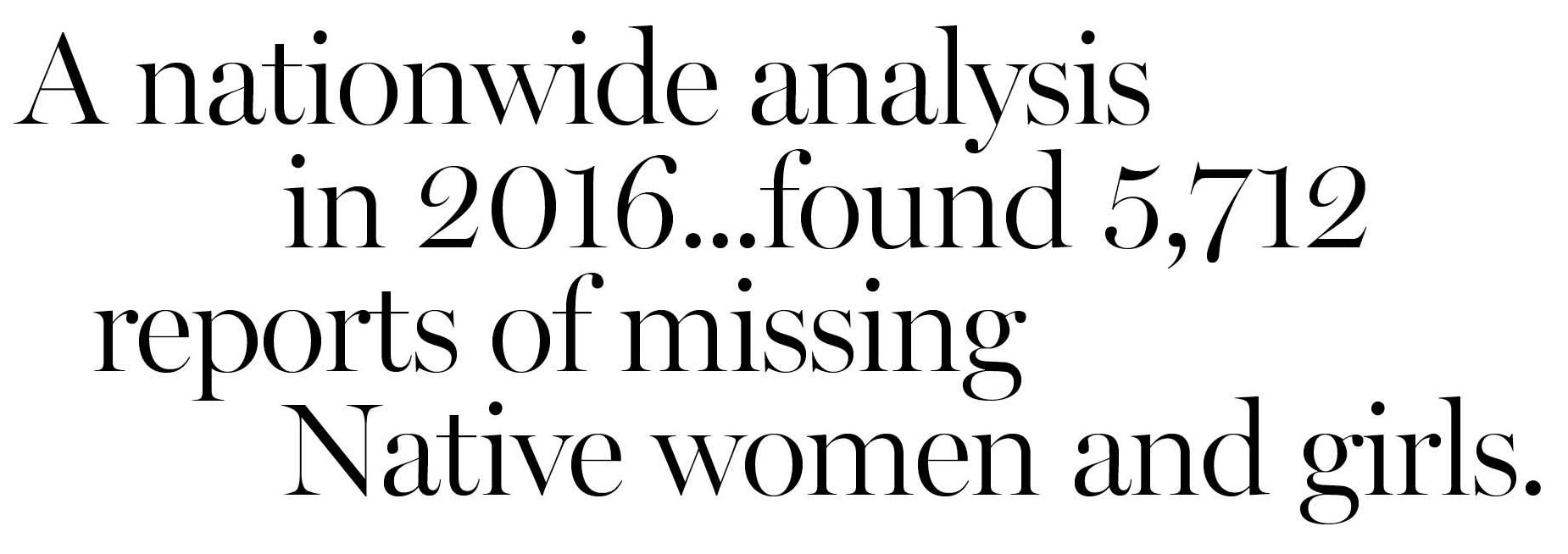
While Ashley’s family waited for tribal police and the BIA (which employs criminal investigators who work alongside tribal police on many reservations) to act, her story was shared hundreds of times across the country through expansive social-media communities, tens of thousands strong, that have for years been dedicated to finding missing Native women. Every week, new faces joined Ashley’s: other women and girls from Native communities across the country who had disappeared or turned up dead. Other families were looking too, like that of Olivia Lone Bear, 32, who vanished from North Dakota’s Fort Berthold Indian Reservation in October 2017, a few months after Ashley. Her family also searched for months, until volunteers found her body in a truck at the bottom of a local lake. (The FBI is now investigating.)
Get exclusive access to fashion and beauty trends, hot-off-the-press celebrity news, and more.
Kimberly suspected that her sister’s disappearance had something to do with Ashley’s new group of friends, but tribal police told her they had not yet found evidence of a crime. She worried they had started too slowly—too skeptically—in those critical first days, that no one had pursued it aggressively enough. Who else would search as fiercely as a family?
It’s harrowing for any family when a loved one goes missing. But on the 326 reservations in the U.S., the deaths and disappearances of Native American women are more frequent, less visible, and often harder to solve, due to ineffective law enforcement and prejudice. There is no official data on the number of cases since no agency is tasked with tracking it. A nationwide analysis in 2016 from the National Crime Information Center found 5,712 reports of missing Native women and girls.
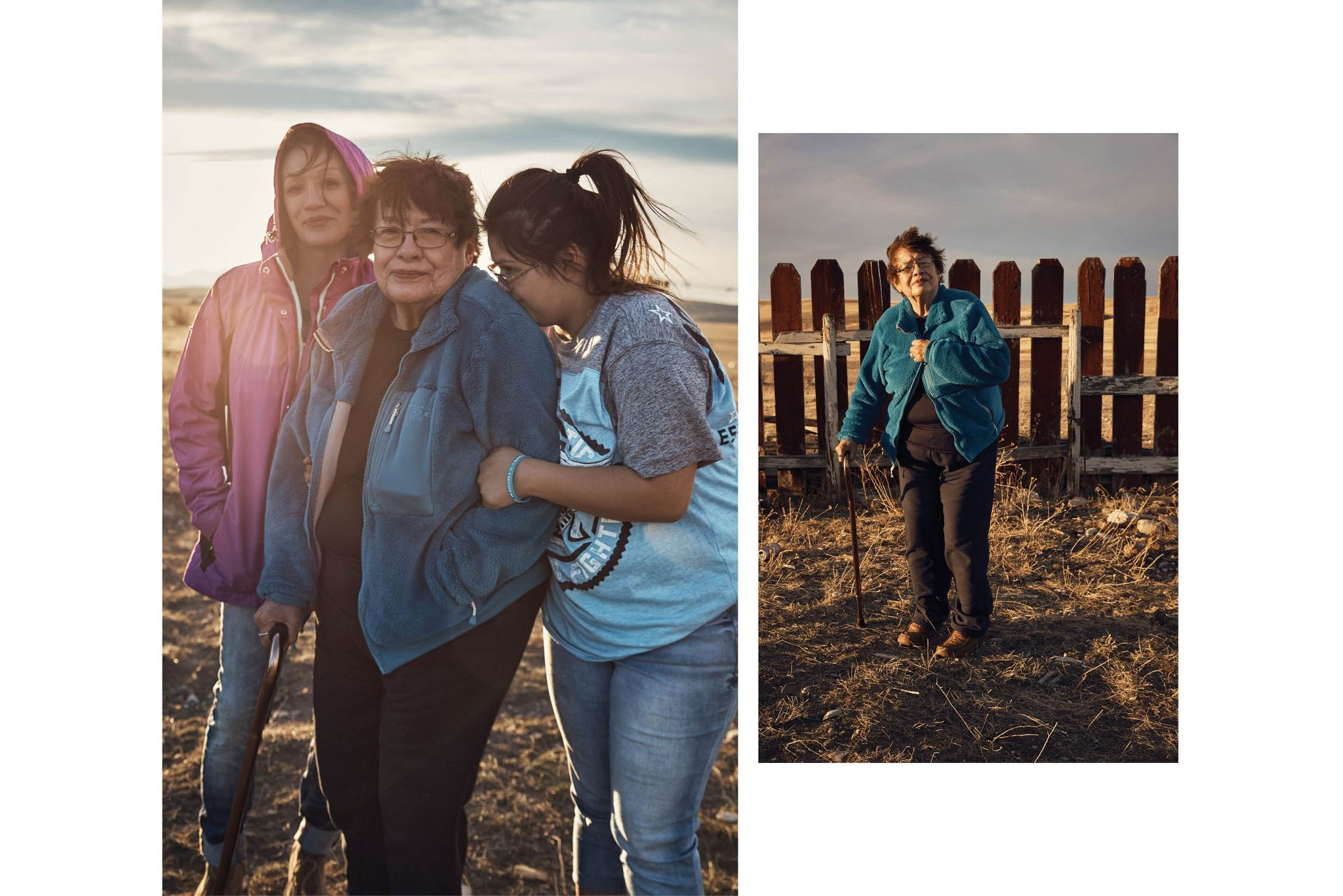
Left: Three generations of Loring women—Ashley's mother, Loxie Lynn, grandmother Loxie, and younger sister, Jonnilyn. Right: Loxie Loring.
The data we do have about violence against Native women is staggering. In 2016, the National Institute of Justice found that nearly 85 percent of Native women have experienced violence like rape, stalking, and beating—crimes known to accompany abduction and murder. Nearly 40 percent encountered such violence in the past year alone, compared with just 23 percent of white women. A 2017 Centers for Disease Control and Prevention study examined more than 10,000 murders from 2003 to 2014, finding the overall rate of murder for Native women to be almost three times that of white women. On many reservations, they are murdered at 10 times the rate of the general population. (According to the CDC, black women are murdered at a slightly higher rate than Native women.) Plenty of violence also occurs off tribal land; 71 percent of Native Americans live in urban areas where, a 2018 report from the Urban Indian Health Institute found, data collection on crimes against them is usually even scarcer.
Yet despite these documented vulnerabilities, it is common for families like Ashley’s to be dismissed by law enforcement when they report disappearances. Lissa Yellowbird-Chase is a member of the Mandan, Hidatsa, and Arikara Nation and founder of the Sahnish Scouts, a volunteer corps of searchers based in Fargo, North Dakota, that aids families looking for loved ones. She’s helped lead more than 75 searches for missing people since 2012, two thirds of them Native. In North Dakota, she helped recover the body of Olivia Lone Bear using volunteers and sonar. She says Ashley’s case is tragically typical; many families she helps are lucky if a police report even gets processed. “It’s pretty shocking when the person who does the intake says, ‘OK, we got it,’ and walks away,” says Yellowbird-Chase, whose own 27-year-old niece was shot and killed on North Dakota’s Spirit Lake Reservation in 2016. (Three men were convicted of her murder.)

Left: Mark SureChief is a family friend who has worked in search and rescue and helped look for Ashley. A trailer in the village of Blackfeet.
Lisa Brunner, codirector of Indigenous Women’s Human Rights Collective, says some blame belongs to the “party girl” stereotype, in which Native women are assumed to be on benders, hampering serious police responses in the hours and days after a disappearance. “Someone goes missing, a family reports it to law enforcement, they’re not responding, and the family goes and looks,” she says. Sarah Deer, a University of Kansas professor who has studied this problem for decades, says this cavalier dismissal is rooted in racism and is found in agencies on both tribal and federal levels. “[The assumption is,] if you’re an adult and a person of color, you’ve probably done something wrong,” she says. “So we’re not going to look for you or protect you because you’re not innocent.”
In 2013, Hanna Harris, 21, disappeared on Montana’s Northern Cheyenne Indian Reservation. Her mother, Malinda Harris Limberhand, says tribal police told her Harris, who had a 10-month-old baby at home, was probably drinking somewhere. Limberhand organized her own search party on social media. Harris’s body was found days later in a ditch. An acquaintance named Eugenia Ann Rowland is serving 22 years in prison for her murder. “I think it’s fair to say, if this was virtually any other group in our country, you would have seen a much louder public outcry,” says Senator Steve Daines (R-Mont.), who worked with advocacy groups like the National Indigenous Women’s Resource Center (NIWRC) to pass a congressional resolution naming May 5, Harris’s birthday, a national day of awareness and remembrance. “Most of them never make any headline at all.” Daines, who is familiar with Ashley’s case, says that in several cases, BIA investigators did not follow legitimate leads. (The BIA and Blackfeet Law Enforcement Agency did not respond to interview requests.) “So one of the cries for help from these Native women has been ‘We’ve got leads; in fact, we think we have some probable suspects here,’ and it falls on deaf ears.”
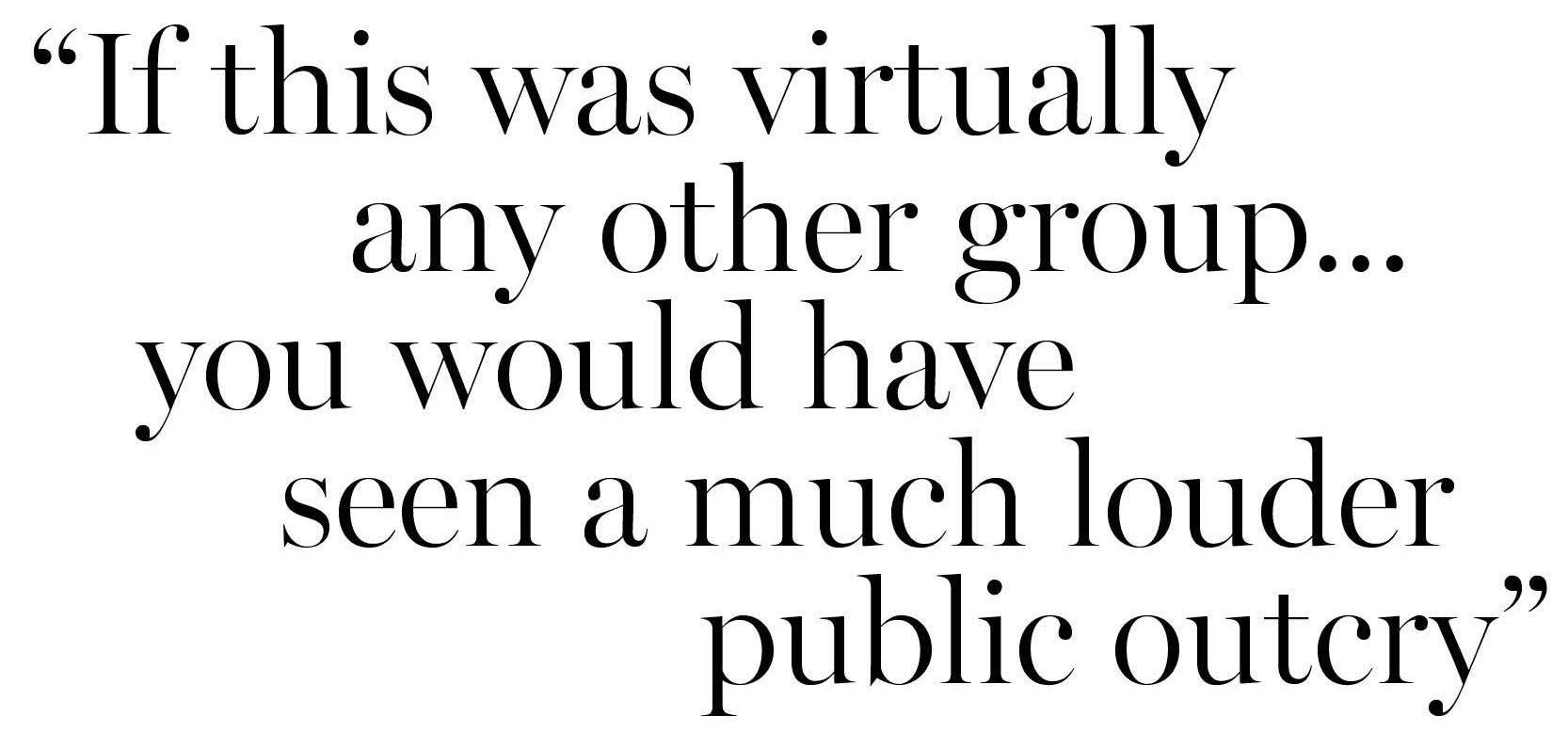
What makes cases like Ashley’s uniquely challenging is the complexity of the criminal-justice system on reservations, where numerous agencies—from neighboring sheriffs’ departments to the FBI—can be involved in solving one crime, leading to confusion, lack of accountability, and the ability to pass the buck. When a Native woman disappears, whose responsibility she becomes depends on where the crime took place. Outside of the context of domestic violence, tribes have no authority over non-Native people who hurt them on their own land; tribe members also may decide not to report the crime to the tribal authorities because the maximum penalty a tribal court can impose is one year. For longer sentences, most tribes must rely on federal agencies. The conundrum is clear: If Ashley was harmed on the reservation, the federal government is obligated to investigate, but if she was harmed elsewhere, other agencies, like county sheriffs’ departments, would take the lead. If nobody knows where—or if—a crime took place, as with many disappearances, it falls to tribal police, with help from the BIA, to gather evidence.
In this, many forces are hamstrung. “Most tribes are simply too poor to establish a comprehensive functioning criminal-justice system,” says Deer. They rely on inconsistent grant-based federal support, making developing programs difficult and resulting in too few officers patrolling vast territories. Many reservations lack 24-hour police coverage, with backup miles or hours away, and most have no access to widely used databases that facilitate criminal background checks. The Tribal Law and Order Act of 2010, which expanded law-enforcement capabilities in Indian country, was intended, in part, to rectify this. But by 2018, agencies from just 51 of 573 federally recognized tribes were enrolled in the DOJ’s Tribal Access Program, which connects them to national crime information systems.
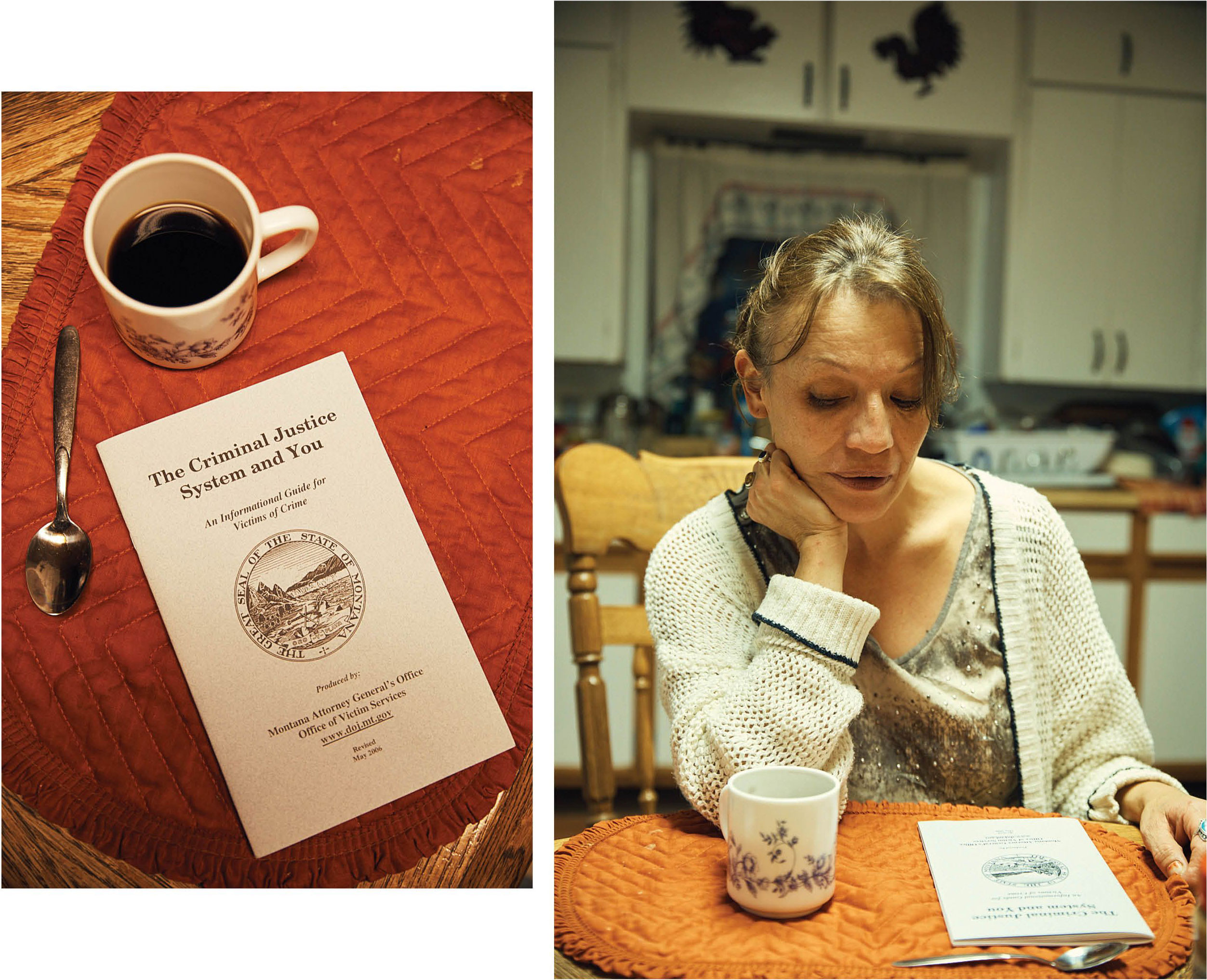
Left: A pamphlet give by law enforcement to help families navigate the system. Right: Ashley's mother, Loxie Lynn.
In fact, until 2017 tribal police did not have the ability to issue Amber Alerts for missing children—even in Montana, where at press time at least 30 percent of missing children are Native American. In 2016, when 11-year-old Ashlynne Mike was abducted and murdered on the Navajo Nation Reservation—a territory around the size of West Virginia—an Amber Alert was not issued until nearly eight hours after she was reported missing. Former senators Heidi Heitkamp (D-N.D.) and the late John McCain (R-Ariz.) sponsored 2017’s Amber Alert in Indian Country Act to help expand tribal capacities.
The Indian Law and Order Commission, an independent volunteer national advisory group tasked with evaluating how to make Native communities safer, called this situation a quagmire that offers criminals impunity to the “endangerment of everyone living in and near tribal communities.” In 2016, the U.S. Department of Justice found that U.S. attorneys across the nation had declined to prosecute more than half the violent crimes on reservations, often because no one had found enough evidence. Though reports from 2017 suggest these numbers are beginning to improve, Heitkamp points to the difficulty prosecutors face. “We have a challenge getting people to investigate these crimes, especially when they’re missing,” she tells MC. “Somebody could just disappear, and as long as there wasn’t enough evidence to presuppose that something bad had happened or a crime was committed, they just got counted as a missing person.”
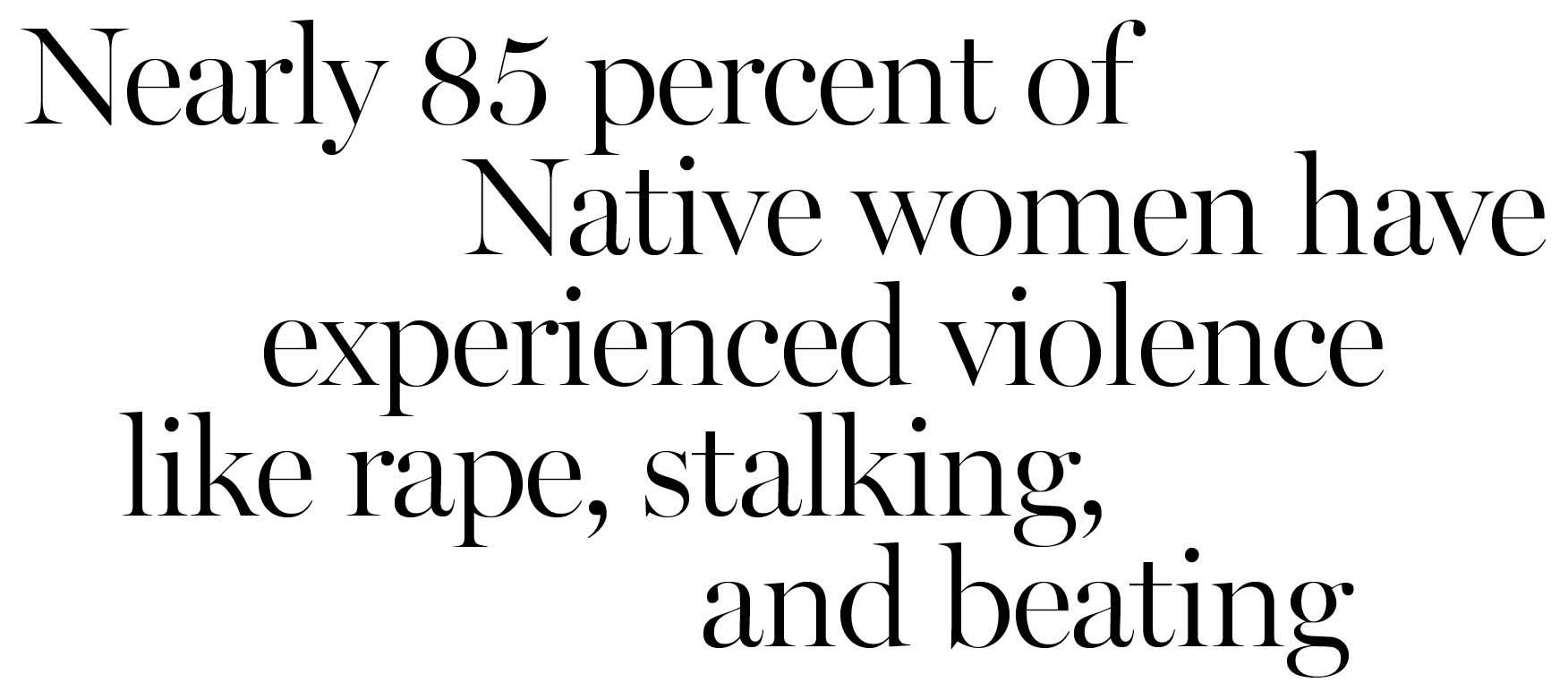
Taking serious action has largely fallen to people on the ground, specifically to the determined activism of the digitally savvy movement Missing and Murdered Indigenous Women and Girls (MMIWG), led by Native women. The NIWRC even publishes a guide, “Tribal Community Response When a Woman Is Missing,” to equip communities for conducting searches. Cherrah Giles, a member of the Muscogee (Creek) Nation and NIWRC board chair, says, “When a higher number of any population goes down and we’re doing nothing about it, those people who are left behind have to be that voice to say, ‘What are we going to do about it?’”
In the fall of 2017, off a gravel road near the Blackfeet reservation’s border with the national park, a band of five searchers follows Kimberly through the sleet into the yellowing brush. Four months after her first search began, the treks have grown cold. They expect the season’s first blizzard that evening and want to cover new ground before it arrives.
The searchers split up and fan out along winding bear paths, while branches whip their faces with rain. They use code names on their walkie-talkies in case anyone—maybe “bad people,” maybe killers—is listening in. They pretend they are out hunting game, not evidence of a crime, armed with only bear spray and bells. It’s the first time Mark Surechief, a family friend, has searched with Kimberly. As an experienced hunter who has worked on wilderness search and rescue teams, he knows what to look for: mostly bones. It’s unlikely a body would last this long intact. The searchers pick through bones scattered among groves of aspen, examining what might be human. It would be easier with dogs, Surechief says. He wants one of his dogs to be trained as a cadaver retriever, which he believes the tribe needs. He surveys the foothills covered by dark pine trees and says, “There’s just so many places someone could leave someone.”

A sign for Blackfeet Housing in Browning, the largest town on the reservation and where Ashley went to community college.
In a clearing, they find piles of crushed Bud Light cans at a “party spot.” A woman fishes out an old makeup compact from the grass. “Ashley’s?” she asks the group. No one knows. From their perspective, anything might be hers. Nobody verbalizes what everyone must be thinking: what it will be like if they actually find something. “I’m trying to stay sane,” Kimberly says. “I don’t want to be thinking I’m looking for my baby sister’s body somewhere in the mountains.”
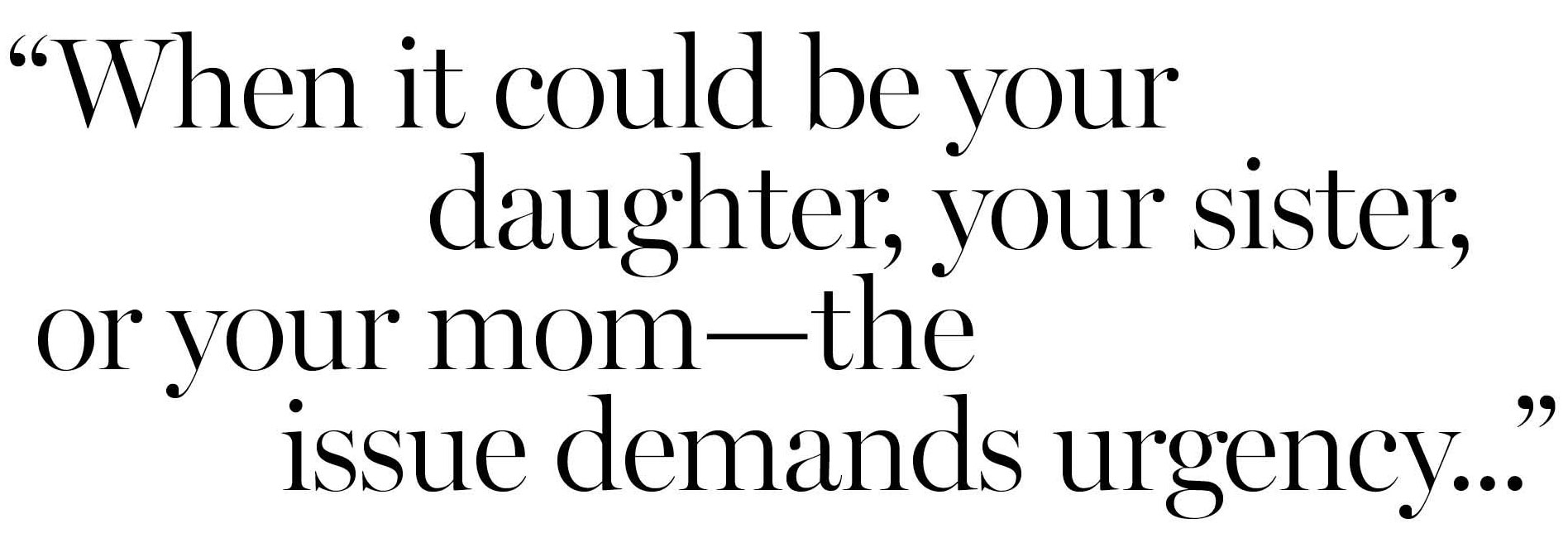
Police had assured Kimberly the investigation was progressing, but she understood little about what they were actually doing and didn’t believe they followed the leads she was fielding. Over that first summer, the BIA conducted several searches. There were firefighters and four-wheelers, she says, but no one turned up anything. “After that, I never saw them again. Just volunteers.” She passed along potential evidence—her team once found a stained sweater with gray stripes and a heart on the back that a local waitress claimed was Ashley’s in a garbage pile—but months later, Kimberly was still waiting for police to send the shirt to the forensics lab.
On the way to the next site, the car bumps through a rocky pasture on private property where an acquaintance told them to look. The searchers crest a hill where a derelict trailer creaks in the wind, then follow the slope down toward a clearing. Kimberly grows antsy: A psychic once described to her a scene exactly like this, promising that Ashley was left there. A few feet away, the wreck of a second trailer is flattened by wind. They lift up grimy plywood and broken appliances. Around the side of the trailer is an abandoned white car punctured with bullet holes. The searchers gather around the broken windows. Someone with gloves peels out a woman’s blue tank top and seals it in a plastic bag. Then they start bagging shell casings too. Kimberly had known her sister was going through a hard time, but she never thought she’d be looking for traces of her among bullets.

Searchers came across this bullet-riddled car while searching for Ashley.
Kimberly had left Browning for Missoula as soon as she could, at 18, and assumed Ashley would eventually join her. Before that, they lived with their grandparents, who legally adopted the sisters, along with an older brother and a younger, third sister. (Their mom was unable to care for them at the time; their dad lived nearby and also helped raise them.) Kimberly, then just seven, always made sure her little sisters were all right, an instinct that never left her. Now she logs her regrets about everything she ever missed with Ashley: holidays, birthdays, school events, the months of heartbreak Ashley spiraled through before she went missing.
Ashley loved makeup and high heels; a prom photo shows her grinning in a cloud of fuchsia and tangerine tulle. She also loved horses and bow hunting. At school, she wrote term papers about mountain-goat conservation and the uprising at North Dakota’s Standing Rock Sioux Reservation. “Ashley was proud to be Blackfoot,” says Annita Lucchesi, one of Ashley’s community-college teachers. The Ashley she knew was a straight-A student with serious goals, like attending the University of Montana, who cared deeply for her people. “That’s why I couldn’t believe it was her at first.”

Top: Ashley's younger sister, Jonnilyn, holds up her old prom dress. Bottom: Ashley's high school ID.
For several years, Lucchesi has been compiling a meticulously researched database of MMIWG cases, the only comprehensive one that exists in the U.S. For her master’s thesis in American studies, she wrote about mapping indigenous experiences of genocide but could not find reliable data. Independent of her academic work, she started collecting information in a spreadsheet from community lists, police records, news articles, and other sources. The process was excruciating: Every day she read about women stabbed, beaten, and left to die in ditches and under trailers. In 2016, Roylynn Rides Horse, 28, a mother of six, was beaten, doused with gasoline, and set on fire, alive, on Montana’s Crow Indian Reservation; she died in the hospital two months later. In 2016, the body of Emily Blue Bird, 24, a mother of two, was found by a grassroots search party initiated by the family in a creek on South Dakota’s Pine Ridge Indian Reservation. One of the hardest tasks was entering Ashley’s name. Lucchesi, who is now the executive director of Sovereign Bodies Institute, a nonprofit dedicated to research on gender- and sexual-based violence against indigenous people, sees herself in these women. She has come to view the database as a form of prayer. “I think that these spirits are very hurt,” she says of the thousands of women and girls she has gathered. “It feels good to them to be counted.”

A stretch of road outside of Browning.
In finding names, nothing has been more helpful than social media, where desperate families and tireless activists post photos and updates daily. “Everybody had these stories: ‘She just left one day, was going to the store,’” says Giles of the NIWRC. But through social media, the grassroots conversation unfolded in real time. When a daughter, sister, mother, or aunt goes missing, families can immediately post images—digital versions of missing-persons fliers—to dozens of Facebook pages, like Navajo Nation Missing Persons Updates (13,000+ followers), Lost and Missing in Indian Country (36,000+ followers), and Missing and Murdered Indigenous Women USA (22,000+ followers). The fortunate families post “safe” updates when their loved ones are found. But countless others, like Ashley’s, keep reposting entreaties for years, creating online repositories of lives and faces that together suggest a larger pattern of violence—something much darker than just a few women lost here and there. Now when women disappear, says Giles, “we can ask questions.”
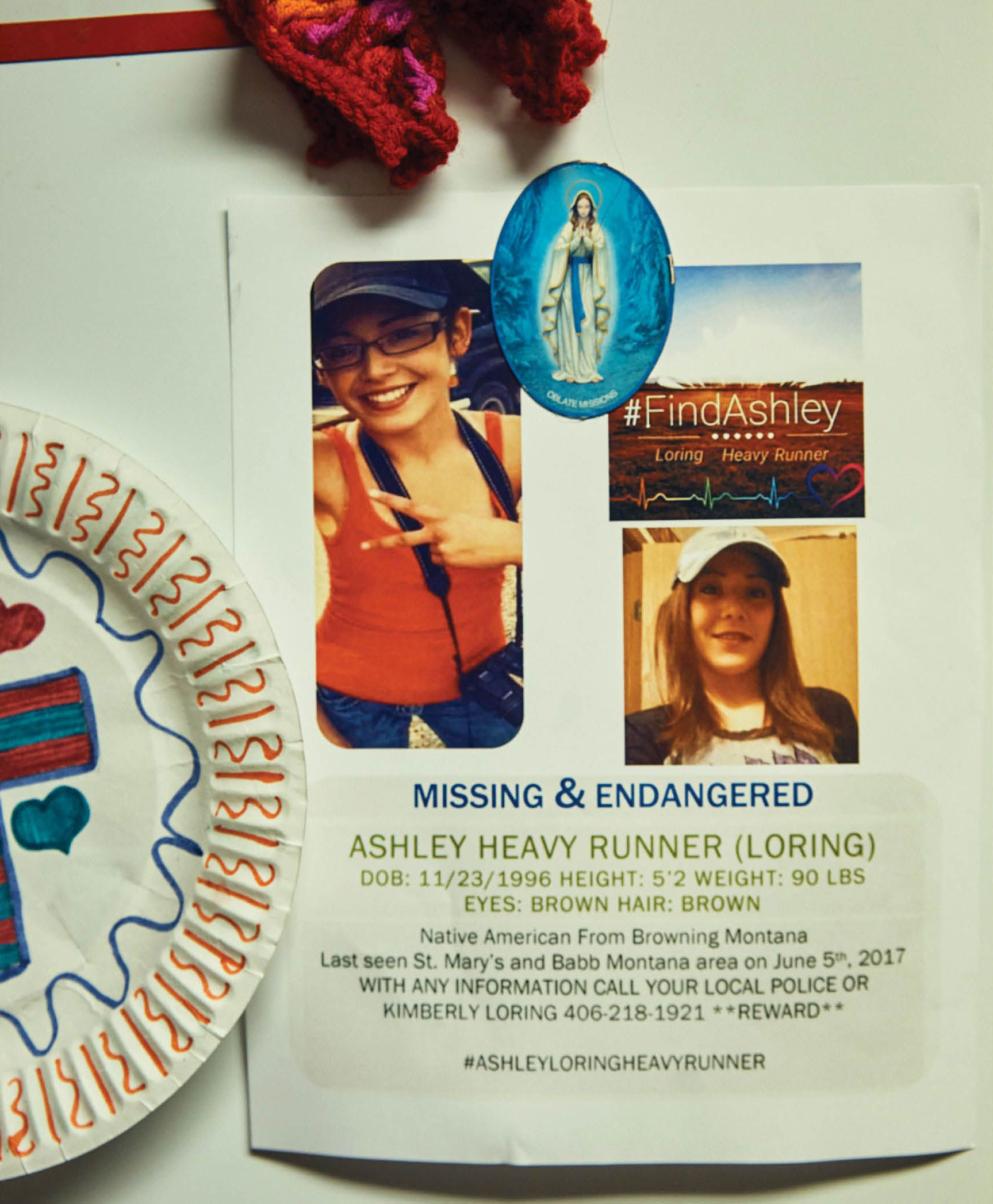
Ashley's missing poster, posted on the refrigerator in Ashley's mom's house.
A similar movement started more than 20 years ago in Canada, where indigenous communities mourned a high number of vanished and murdered women. One highway, dubbed the Highway of Tears, which passes through several reservations in British Columbia, saw dozens of murders. Meanwhile, serial killer Robert Pickton confessed to killing 49 women, many of them indigenous, on his pig farm outside Vancouver. (He is currently serving a life sentence.) No one else was paying attention to the trend, so indigenous women began holding rallies and marches. Like their U.S. counterparts, they tallied their own numbers, with one group counting more than 4,000 victims. Under pressure, in 2014 the Royal Canadian Mounted Police documented 1,181 victims—meaning 16 percent of Canada’s murder victims came from a group that made up just 4.3 percent of the total population.
That year, when the body of Tina Fontaine, 15, was found wrapped in plastic in Winnipeg’s Red River, public outcry intensified. Politicians demanded an official accounting for the deaths. In 2016, under the new administration of Prime Minister Justin Trudeau, Canada launched a multiyear National Inquiry Into Missing and Murdered Indigenous Women and Girls. Though it has been criticized for focusing on addressing root causes rather than meting out justice for neglected victims, many call it a first step in recognizing the human-rights crisis long hidden within their borders. “The attack on our young women is an attack on our future nation,” says Bernadette Smith, an indigenous activist and a member of the Manitoba legislature whose sister, Claudette Osborne-Tyo, went missing in 2008 and was never found. “If you take our young women, there’s not going to be a future.”
Stories like Osborne-Tyo’s now appear regularly in Canadian national media. Not so in the United States, where such cases have rarely been visible beyond Native communities. But this too is changing. In August 2017, 22-year-old Savanna LaFontaine-Greywind, a member of the Spirit Lake tribe, was eight months pregnant when she vanished in Fargo after visiting neighbor Brooke Crews. For eight days, her disappearance sparked wrenching posts across Facebook, where her image was shared thousands of times. Her body was eventually found in the same Red River that flows down from Winnipeg, while her child was found alive in Crews’s apartment. Crews had cut out the baby, who is now safe with her father, while LaFontaine-Greywind was still alive. (Crews pled guilty to conspiring to commit kidnapping and murder and is serving a life sentence.)

The shock of the murder brought widespread mourning and outrage to Native communities and made national headlines. Late in 2017, after she and McCain secured the passage of the Amber Alert in Indian Country Act, Heitkamp introduced new legislation, called Savanna’s Act, a bill with bipartisan support aimed at studying, solving, and stopping the killings. “As we began to look at this [problem], we said we should be doing something like they’re doing in Canada,” Heitkamp says. Savanna’s Act would, among other things, mandate the Department of Justice to specifically track data on MMIWG, with an annual report to Congress—and the quality of the data would be improved by training law enforcement to recognize and record victims’ tribal affiliations in the first place. It would also supply tribal governments with better resources and require investigating agencies to standardize protocols for how they coordinate and respond to every single case so when someone goes missing in Indian country, there’s no question of who’s in charge. Though Heitkamp, who lost her seat in the 2018 midterm elections, made Savanna’s Act her final priority, the bill was blocked in the House after passing the Senate unanimously. Cosponsor Senator Lisa Murkowski (R-Alaska), along with Senator Catherine Cortez Masto (D-Nev.), reintroduced the bill earlier this year.
In January, Democratic representatives Deb Haaland of New Mexico and Sharice Davids of Kansas became the first Native American women to serve in the U.S. House, bringing to Congress long-missing voices for Native women. “When your community is at risk—when it could be your daughter, your sister, or your mom—the issue demands urgency, and finally we have a political voice to raise this issue on the national level,” says Haaland, who has vowed to safeguard protections for Native women. “It wouldn’t have been possible without the women in Indian country who are saying, ‘Enough is enough. We deserve to feel safe too.’” Meanwhile, Minnesota, Montana, and Washington State have introduced or passed their own legislation to track MMIWG data, rally resources, and end the violence. All this, thanks to strong Native voices who can’t afford to give up. “That’s how Canada ended up with an inquiry,” Lucchesi says. “There were people fighting for it for 20 years.”
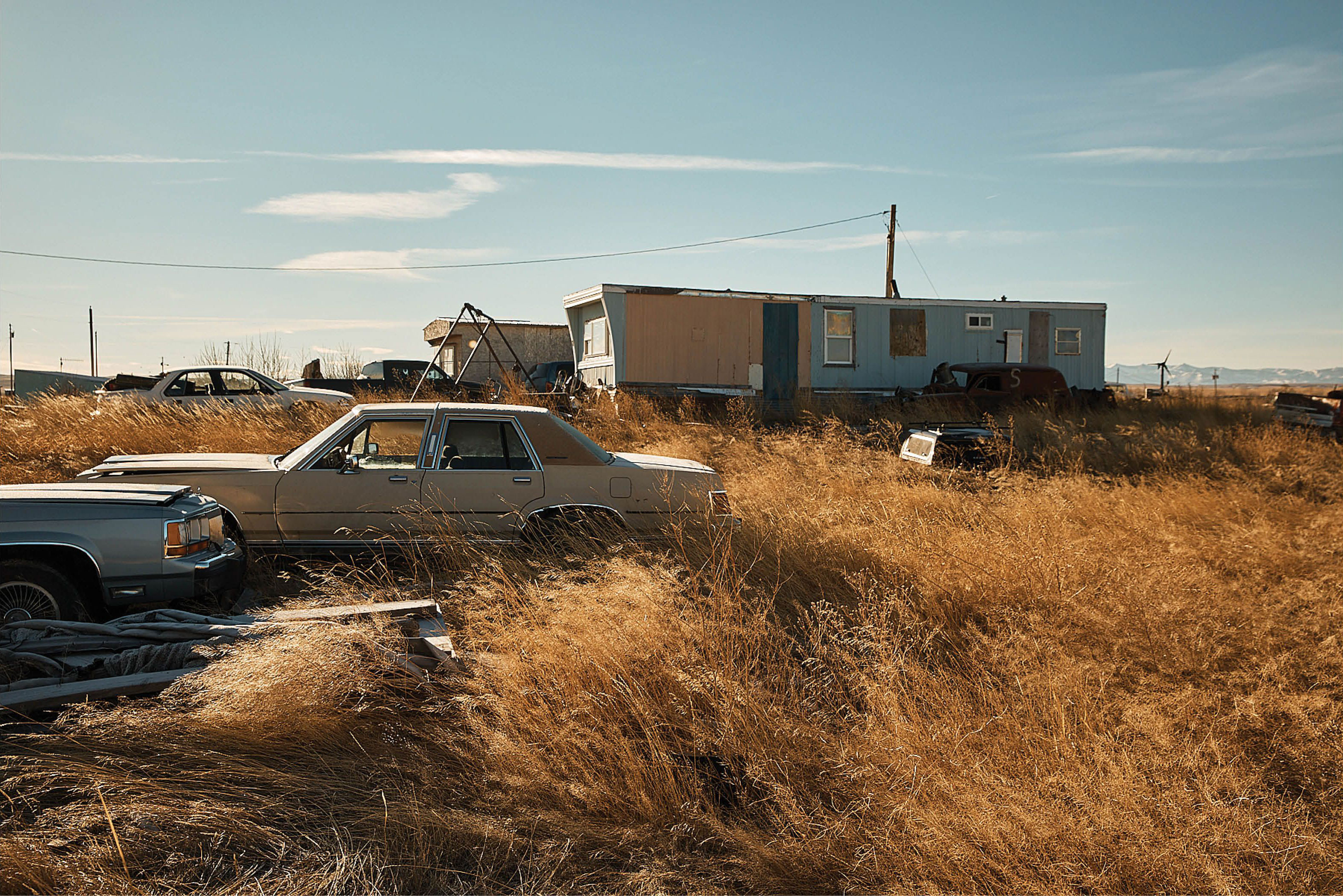
Trailers and cars in Blackfeet.
When dusk approaches in Montana, the searchers start packing up, but Kimberly retreads ground along the creek. She stumbles on a mound partly covered in grass and kicks around its outline. It’s possible something big was buried there. She grows agitated. For families like hers, desperate hope and searing dread are always linked, inextricable in the possibility of finding someone. She calls Surechief over. Everyone waits while he kneels down. He looks back at Kimberly and shakes his head. It’s the work of a badger.
On the drive home, clouds glint between mountains. Empty miles unfold along the highway, where tufts of tumbleweed gust by. Kimberly has returned from searches on these roads so many times with nothing. The wilderness feels vaster, its crevasses deeper, the longer she wanders it empty-handed. “You don’t know how strong you are until you have to go through hell,” she says. That night, the season’s first storm howls in, knocking out power lines and closing down roads. Millions of acres—everywhere Kimberly’s raked and scoured—are buried in thick, quiet sheets of snow.

Birthday candles from the celebration of Ashley's 21 birthday, which they held without her.
Shortly after Ashley disappeared, her grandmother started putting away money. “I didn’t know if I was going to have to use it for a plane ride somewhere if they found her elsewhere,” Loxie Loring says. Now, though, she knows she might have to spend it on a funeral. On Ashley’s 21st birthday in November 2017, her family had a party with candles, cake, and a poster scrawled with heartsick entreaties to please come home. On her 22nd birthday, they simply sang “Happy Birthday.”
Over time, they have caught themselves using the past tense, remembering all the things Ashley “was” instead of “is.” Some still hope she may have been trafficked, if only for the possibility of finding her alive. In early 2018, the FBI agreed to investigate Ashley’s case at the BIA’s request, but her family fears the move came too late, that the evidence they need has vanished too. “I believe that if law enforcement had searched for my sister when she first went missing, if they had taken her seriously, we would have my sister,” Kimberly testified at a U.S. Senate Committee on Indian Affairs hearing on MMIWG last December. The next day, the parents of 14-year-old Henny Scott of Montana’s Northern Cheyenne Indian Reservation reported their daughter missing. Like Ashley’s family, they said their concerns were minimized by local BIA agents and her disappearance was not reported to the public for nearly two weeks. On December 28, Scott’s body was found by a volunteer search party, buried in a snowdrift. “I am here to stress to you we are important and we are loved and we are missed,” Kimberly had told the Senate committee. “We will no longer be the invisible people in the United States of America.”
Two years after Ashley disappeared, Kimberly still sees her everywhere, including in her dreams. In them, she chases her sister but can’t catch her or she holds her and tells her she loves her. One morning, she wrote on Facebook, “Reality hits you and that empty dark feeling slowly covers you. And you realize your sister is missing and even though you looked and looked you can’t find her.” Her family keeps Ashley’s things near, some of them tucked in a cardboard box: a camera filled with hundreds of photos of mountains, animals, friends, and selfies; old math tests and trophies; a biography of Robert Pattinson; an acceptance letter from the University of Montana, a tender crease frayed from being unfolded over and over. On a high school worksheet on Adrienne Rich’s poetry book An Atlas of the Difficult World, Ashley had marked this passage: “I know you are reading this poem … on a gray day of early spring/faint flakes driven across the plains’ enormous spaces around you.” She highlighted the phrase “faint flakes” as her favorite, writing, “The word faint reminds me of myself as I disappear like a flake in the snow.”
This story originally appeared in the June 2019 issue of Marie Claire.
